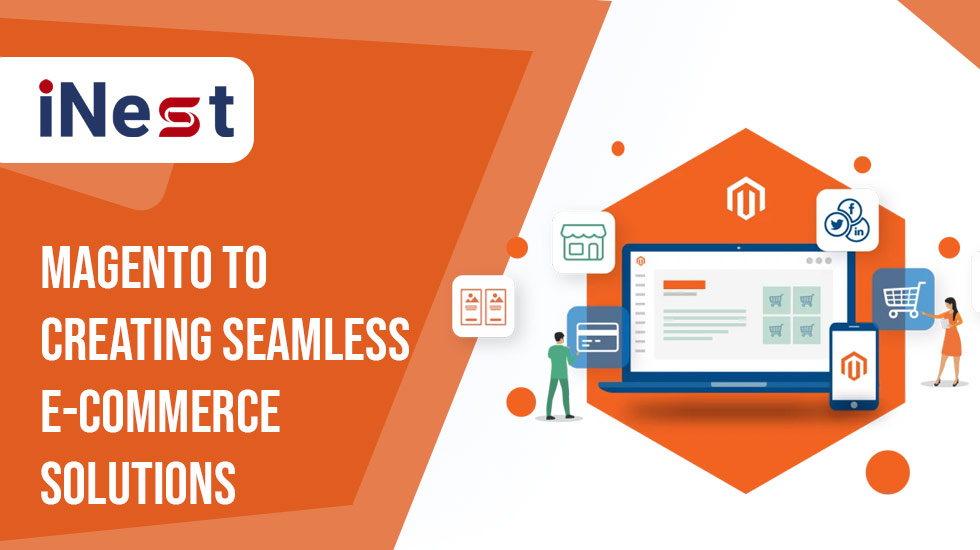Are you ready to revolutionize your e-commerce business? Look no further than Magento Web Development Guide. With its powerful and flexible features, Magento is the go-to platform for creating seamless e-commerce solutions that will take your online store to the next level.
When it comes to building an engaging and user-friendly online store, Magento is a game-changer. Its robust functionalities, customizable themes, and user-friendly interface make it the perfect choice for businesses of all sizes. And with the growing demand for e-commerce solutions in India, leveraging Magento’s power can help you stay ahead in this competitive market.
With the expertise of skilled Magento developers in India, you can unlock the true potential of this platform. From designing attractive and responsive websites to integrating secure payment gateways, these professionals can provide you with a tailored solution that meets your specific business needs.
So, if you’re ready to enhance your e-commerce presence and boost your sales, it’s time to tap into the power of Magento web development in India. Get ready to create a seamless online shopping experience for your customers and drive your business to new heights.
Magento Web Development Guide
Magento offers numerous advantages for businesses looking to establish a strong online presence. Firstly, its open-source nature provides businesses with the freedom to customize and extend the platform according to their specific requirements. This means that you can create a unique and personalized online store that reflects your brand identity.
Secondly, Magento offers a wide range of features and functionalities that are designed to enhance the overall user experience. From seamless navigation to advanced search capabilities, Magento ensures that your customers can easily find and purchase the products they need. Additionally, Magento offers built-in marketing tools such as promotions, upsells, and cross-sells, allowing you to boost your sales and maximize your revenue.
Moreover, Magento is highly scalable, which means that it can grow with your business. Whether you’re a small startup or a large enterprise, Magento can handle thousands of products and orders without compromising on performance. This scalability ensures that your online store can handle increasing traffic and sales as your business expands.
Key features of Magento web development
Magento offers a wide range of features that make it the preferred choice for e-commerce development. One of the key features is its robust catalogue management system. With Magento, you can easily create and manage product catalogues, including attributes, categories, and pricing options. This allows you to organize your products effectively and provide your customers with a seamless shopping experience.
Another important feature of Magento is its advanced order management capabilities. From processing orders to tracking shipments, Magento provides businesses with a comprehensive system for managing their sales. Additionally, Magento offers built-in customer management tools, allowing you to create customer accounts, track customer behaviour, and provide personalized experiences.
Furthermore, Magento offers a range of marketing and promotion tools to help you attract and retain customers. With features such as discounts, coupons, and reward points, you can incentivize your customers to make repeat purchases and increase customer loyalty. Additionally, Magento integrates seamlessly with popular email marketing platforms, allowing you to send targeted campaigns and newsletters to your customers.
Choosing the right Magento version for your e-commerce website
When it comes to choosing the right Magento version for your e-commerce website, it’s important to consider your specific business needs and requirements. Magento offers two main versions: Magento Open Source (formerly known as Magento Community Edition) and Magento Commerce (formerly known as Magento Enterprise Edition).
Magento Open Source is the free version of Magento and is suitable for small to medium-sized businesses that have limited budgets. It offers a wide range of features and functionalities, including catalog management, order management, and marketing tools. However, it does not include some of the more advanced features and support options that are available with Magento Commerce.
On the other hand, Magento Commerce is the paid version of Magento and is designed for larger businesses that require more advanced features and support. It offers additional features such as customer segmentation, advanced marketing tools, and access to Magento’s support team. Additionally, Magento Commerce provides businesses with enhanced security and performance options, making it the preferred choice for enterprises.
Steps to set up a Magento e-commerce store in India
Setting up a Magento e-commerce store in India is a straightforward process that involves several key steps. Here’s a step-by-step guide to help you get started:
- Choose a hosting provider: The first step is to choose a reliable hosting provider that can support your Magento store. Look for a provider that offers good uptime, fast loading speeds, and excellent customer support.
- Install Magento: Once you’ve chosen a hosting provider, you can proceed to install Magento. Most hosting providers offer one-click installation options, making it easy to set up your Magento store.
- Configure your store: After installing Magento, you’ll need to configure your store settings. This includes setting up your store name, contact information, and payment options. You’ll also need to choose a theme for your store and customize it according to your brand identity.
- Add products: The next step is to add products to your Magento store. This involves creating product categories, adding product attributes, and uploading product images and descriptions. Make sure to optimize your product listings with relevant keywords to improve your search engine rankings.
- Set up payment and shipping methods: To enable seamless transactions, you’ll need to set up payment and shipping methods. Magento offers a range of payment options, including popular gateways such as PayPal and Stripe. You can also configure shipping options based on your business requirements.
- Test and launch: Before launching your Magento store, it’s important to thoroughly test its functionality and performance. Make sure to test all the features, including product browsing, adding items to the cart, and completing the checkout process. Once you’re satisfied with the testing results, you can launch your store and start driving traffic to it.
Best Practices for Magento Web Development Guide
To ensure the success of your Magento web development project in India, it’s important to follow best practices. Here are some tips to help you create a seamless and user-friendly online store:
- Optimize your website for speed: Slow loading speeds can lead to high bounce rates and poor user experience. Optimize your Magento store by compressing images, minifying CSS and JavaScript files, and using caching techniques.
- Implement responsive design: With the increasing use of mobile devices for online shopping, it’s crucial to ensure that your Magento store is mobile-friendly. Implement responsive design techniques to provide a seamless experience across different screen sizes.
- Ensure website security: Protect your Magento store and customer data by implementing security measures such as SSL certificates, secure payment gateways, and regular security audits. This will help build trust with your customers and prevent any potential security breaches.
- Regularly update your Magento installation: Magento regularly releases updates and patches to address security vulnerabilities and improve performance. Make sure to keep your Magento installation up to date to benefit from the latest features and security enhancements.
- Optimize your website for SEO: Implementing SEO best practices can help improve your search engine rankings and drive organic traffic to your Magento store. Focus on optimizing your product pages, meta tags, URLs, and implementing a solid internal linking strategy.
Customizing your Magento store for a seamless user experience
One of the key advantages of Magento web development is the ability to customize your online store according to your specific business requirements. Here are some ways you can customize your Magento store for a seamless user experience:
- Customize your theme: Magento offers a wide range of customizable themes that allow you to create a unique and visually appealing online store. Choose a theme that aligns with your brand identity and customize it to reflect your unique style.
- Integrate extensions: Magento offers a vast marketplace of extensions that can enhance the functionality of your online store. From advanced search options to social media integrations, these extensions can help you create a seamless user experience.
- Streamline the checkout process: Simplify the checkout process by removing unnecessary steps and fields. Implement features such as guest checkout, one-page checkout, and address auto-fill to make it easier for your customers to complete their purchases.
- Personalize the shopping experience: Leverage the power of Magento’s customer segmentation tools to provide personalized experiences to your customers. Create targeted promotions, recommend related products, and send personalized emails to increase customer engagement and loyalty.
Integrating payment gateways and shipping methods in Magento
To enable seamless transactions on your Magento store, it’s important to integrate payment gateways and shipping methods. Magento offers a wide range of payment options, including popular gateways such as PayPal, Stripe, and Authorize.net. You can easily configure these payment gateways within your Magento admin panel.
Additionally, Magento allows you to set up multiple shipping methods based on your business requirements. Whether you’re offering free shipping, flat rate shipping, or real-time carrier rates, Magento provides the flexibility to configure and customize your shipping options. This ensures that your customers have a variety of choices when it comes to shipping their orders.
Optimizing your Magento website for SEO
To drive organic traffic to your Magento website and improve your search engine rankings, it’s important to optimize your website for SEO. Here are some tips to help you get started:
- Keyword research: Conduct thorough keyword research to identify relevant keywords and phrases that your target audience is searching for. Use these keywords strategically in your product descriptions, meta tags, and URLs.
- Optimize product pages: Optimize your product pages by adding unique and compelling product descriptions, high-quality images, and customer reviews. Use relevant keywords in your product titles, headings, and alt tags.
- Create SEO-friendly URLs: Ensure that your URLs are clean and SEO-friendly. Use descriptive keywords instead of numbers or random characters to make it easier for search engines to understand the content of your pages.
- Implement a solid internal linking strategy: Interlink your product pages, category pages, and blog posts to improve the overall structure and navigation of your website. This helps search engines crawl and index your website more efficiently.
- Optimize website speed: As mentioned earlier, website speed is a crucial factor for both user experience and SEO. Optimize your Magento website by compressing images, minifying CSS and JavaScript files, and implementing caching techniques.

